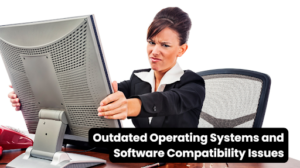BUSINESS
When Should You Upgrade Your Business Servers?

Perhaps your business is experiencing slow, unreliable servers or the inability to function at full productivity. With business operations hinging on its servers, the proper time to upgrade is important.
If outdated and overwhelmed, it can lead to losses, security issues, and less efficiency which affects customer satisfaction and impacts employee productivity. This guide explains the common signs that show that an upgrade is necessary, to keep your business up and running smoothly and securely.
Your Server Is No Longer Supported
Always have a periodical check on your servers as they might be running on old hardware or software. Sometimes manufacturers as well as the providers of the operating system typically end their support for older products.
That implies no more updates, new security patches, and minimal or no technical support. In such a case, servers remain prone to malware and cyber-attacks which can jeopardize your business data.
An aggressive move to prepare for an upgrade when support will be discontinued is to regularly check with your server’s manufacturer or software provider regarding end-of-life timelines. In such situations, prioritize supermicro refurbished servers that can help ensure continued security and compatibility when official support ends, maintaining operational stability and reducing potential risks.
Slow Performance

As the business grows, so will the data, and therefore, there will be an upsurge in the number of data being processed on the servers. If your applications now take a lot of time to open, if your backup processes take longer, or if it is taking longer for data retrieval, then the servers could be bogging under the workload.
Slow server performance significantly impacts productivity since employees will have to wait longer for their files to open, for databases to open, or for critical applications to run.
Server hardware could have limited capabilities, and only upgrading to a specific component can offer temporary relief. Regular performance dips are usually an indication that your servers are overstretched with what they can currently manage. Moving to newer and more powerful surplus servers configurations can bring back speed to an optimal level, help meet aspirations for growth, and preclude costly downtimes.
Higher Maintenance and Downtime Costs
Older servers have to be frequently repaired and serviced, which can quickly eat into your IT budget, rendering it unavailable for more strategic investments. Broken refurbished servers also tend to collapse without any warning, causing significant downtime. Unscheduled downtimes may hurt business revenues, and customer trust may be damaged by the service disruptions. Normal operation hassles lead to frustrated employees and clients due to stoppages.
In case the maintenance costs are rising or when you encounter frequent shutdowns, then this may present an opportunity to transition to new servers with fewer chances of failure, thus saving more in terms of cost and reliability. Newer servers come with warranties and technical support; therefore, these reduce the cost of maintenance and are less uncertain.
Storage Needs Have Increased

As your business grows, so will its data storage needs. Large volumes of customer data, project files, multimedia content, and databases can fill up server storage quickly. Once the storage space reaches capacity, server performance begins to degrade and even data backup might take longer or completely fail. This becomes especially a huge problem if your business depends on high-capacity storage for analytics, large databases, or large digital assets.
There could be a possibility of adding extra storage space in existing servers for now, but if the need for storage is also increasing with each passing time then an upgrade might be better.
Modern servers are always available with relatively higher storage capacities and quicker access, which ensures that your team works without any hindrances due to storage.
Security Risks Are Rising
Due to the number of cyber attacks, it is very critical to secure business servers. Older servers are deprived of most of the many sophisticated security features found in newer pieces of equipment. Updates to older operating systems are no longer available in some cases, which can create holes in the system through which breaches of security can occur. Your data can get compromised at times with security breaches, which might expose some sensitive business information, customer data, and financial records.
At times, the only upgrade possible is for new refurb servers to offer the latest new security features like advanced encryption, automated backups, and integrated firewall protection, just to mention a few. At around the same time, new servers more often than not support the latest security software, so your company remains protected from emerging new threats.
Outdated Operating Systems and Software Compatibility Issues

Your applications might be running on an obsolete operating system, which reduces your ability to add new software and applications. Often, software vendors will release updated versions of applications that must be based upon a current operating system to work properly. If the current servers wholesale cannot support these updates, you’re probably missing out on important features and security enhancements that can impact your team’s performance.
With the current modern used rack servers, you can be sure that it has installed software that is on par with modern levels, hence giving your business the promise of using new functions in a quest to stay ahead of the times.
Compatibility issues, besides ensuring timely up-grading, also make collaboration among departments as the organization introduces newer and better technologies into the business.
Expanding Business Needs

When a business continues growing, the demand may increase, and therefore, it is essential to upgrade such refurb servers to flexible and scalable server infrastructure.
It means that the old servers may become overstrained with a higher number of customers or applications or higher processing power, which may even demand more sophisticated software integration. Businesses rapidly growing may realize that existing servers are no longer capable of handling new users, applications, or customer traffic, resulting in bottlenecks.
A server upgrade will help your business match the IT capabilities in terms of its expansion goals. Scalable server solutions ensure that you have the right infrastructure to absorb future growth without trading off any performance, thus giving comfort that your IT infrastructure will keep up with your business ambitions.
Energy Efficiency and Environmental Impact
This makes older servers usually less energy-efficient, with a need for more power and a greater generation of heat in comparison to their modern versions. Not only is that quite expensive in electricity terms, but the environmental footprint of your business can also grow exponentially.
More and more companies are taking steps towards using more environmentally friendly resources. Upgrading to energy-efficient Dell refurbished servers can be an efficient way to accomplish this.
New servers are designed to be energy-efficient; their latest power supplies, for instance, tend to have more efficiency and waste fewer amounts of energy compared with traditional models. Power consumption cuts form a step toward reducing the cost of running your operations as well as showing commitment to sustainable business practices.
Enhanced Virtualization Support and Cloud Integration

Many organizations transition towards hybrid environments, where a combination of on-premises servers along cloud-based services are being used. Such an environment is flexible and scalable and allows savings in cost.
Cloud integration can sometimes be difficult because of older supermicro refurbished; the older hardware and software might lack compatibility for smooth integration into the cloud, or vice versa, to support virtualization purposes.
They can be made easier and much upgraded through the use of modern servers that support virtualization as well as cloud integration. This can work out to be flexible for the construction of a hybrid IT infrastructure, making it possible to use resources more resourcefully, manage data better, and assure employees have access to data across locations.
Readying for Remote and Flexible Work

More and more employees work from home and remote access to data and applications will become necessary. Older servers can be weak in supporting that type of remote connection, providing slower speeds in accessing data and applications and potentially opening the door to security threats. This could be the time to consider upgrading if you’ve proven to be able to maintain or expand your business based on remote work operations.
Most new supermicro refurbished have incorporated secure remote connection and data access support. Therefore, you will not find yourself compromising your data security when handling your distant employees. Putting in some investment in servers that contain the feature of this capability will always be sure to keep your team on the move while being connected and productive wherever they are.
Your Server Is Reaching Its End-of-Life
When servers reach the end of the manufacturer’s life cycle support, they no longer receive any necessary updates. This is inclusive of security patches and technical support. In any business, this poses a significant risk because of outdated software and hardware due to vulnerability to cyber-attacks.
What’s more, the use of unsupported technology will lead to compatibility issues between modern applications and software, and this could limit your ability to add new tools that could help improve business efficiency. By scheduling periodic checks with your supermicro refurbished manufacturer or software provider regarding their timelines for end-of-life products, you’ll be adequately prepared and ready for an upgrade long before the end of the life cycle.
Higher Energy Expenses and Environmental Issues
Older servers are much less energy efficient than state-of-the-art devices, often using more power and having higher heat, which increases the energy cost and may demand more cooling, adding up to utility costs and maintenance.
Energy inefficiency gradually contributes considerably to operational costs and diverts funds that could otherwise have been allocated to more strategic investments within your organization. Switching over to energy-efficient servers could help you cut down on these cost expenses and reduce the overall carbon footprint of your business.
Apart from cost-cutting, business concerns these days have included saving the environment. Newer energy-efficient servers will support greener campaigns, and sustainable activities can easily help enhance brand image and appeal to sensitive, green-conscious clients and business associates.
Strained Resources and Rising Customer Demand

With every increase in demand from customers, scaling up the server becomes necessary. Older servers may not support a large number of users as before, thereby slowing down response times and causing interruptions in services. If the hardware is old or if there is a processing deficiency, applications can cause bottlenecks.
This ultimately impacts client satisfaction and productivity. By investing in scalable server solutions, your infrastructure can flex and grow with your business and so avoid being held captive by growing demands for better performance.
Modern supermicro refurbished machines have been designed to support resource-intensive applications and gigantic numbers of users with high efficiency. An upgrade to a more flexible and powerful server infrastructure will guarantee smooth operations while ensuring improved client satisfaction and providing employees with the tools needed to work effectively.
Transitioning to Virtualization and Hybrid Environments
More organizations are implementing hybrid IT environments these days-that is, combining cloud services with on-premises servers-and older servers get frustrated with issues of compatibility and efficiency. Flexible, scalable resource management comes through virtualization and integration into the cloud, making it easier for businesses to adapt their infrastructures according to the changing needs of their business.
Older hardware, though, may not necessarily have support for virtualization or interoperability between the cloud and other technologies which slows down the transition toward more dynamic and efficient infrastructures.
Supporting a Flexible and Remote Workforce
With the adoption of remote work and hybrid combinations, working businesses have to take appropriate measures for remote access to data and applications with maximum security from anywhere. Older servers, as they hardly provide secure and fast remote access, usually retain slower speeds that pose a security threat.
Such occasions can deteriorate performance and invite cyber breaches; outdated servers might not support secure remote connection protocols, which poses difficulties for employees to access their required sources efficiently.
New servers, for instance, have better support for remote access and secure data sharing, ensuring distributed teams stay productive and connected while working remotely. Secure remote connections are of great concern to a globally distributed team because they prevent data breaches and ensure employees have seamless access to the tools.
The upgrade of the servers to provide modern remote access capabilities improves productivity and demonstrates a good intent for flexible work solutions, which increases staff satisfaction and retains top talent.
Conclusion
Although upgrading the business servers may not always be easy to figure out, identifying these signals will make it pretty easy. Upgrade to your servers: an investment for the future of your business, ensuring that the IT infrastructure in place ensures growth, safety of data, and a trusted solid backbone for all daily operations.
Upgrading can therefore address issues related to slow performance, high maintenance cost, and limitations in storage, all of which will help build an improved, efficient, resilient, and scalable system that will serve your team and customers.
In case any of the situations mentioned above apply to you, it’s advisable to seek consultation from a professional IT expert in conducting an assessment of your needs for servers. Properly planned upgrades of your server can ensure smooth changes that will not disrupt your productivity.
FAQs
How do I know if my server needs an upgrade?
If your server is slow, frequently down, or has reached end-of-life support, it’s likely time for an upgrade.
Why is it risky to keep using an outdated server?
Older servers lack security updates, making them vulnerable to cyber threats, and may be incompatible with new software.
How does server performance affect my business?
Poor server performance can lead to delays, productivity loss, and increased frustration for employees and customers.
BUSINESS
pedrovazpaulo Entrepreneur: New Wave of Innovation

pedrovazpaulo, widely recognized in the business world, is an entrepreneur known for his forward-thinking approach, strategic insight, and trailblazing ventures. From humble beginnings to building successful enterprises, his journey is one marked by determination, creativity, and an unwavering commitment to turning bold ideas into impactful realities.
With a unique blend of leadership and innovation, pedrovazpaulo entrepreneur has carved a niche in industries ranging from tech to sustainability, inspiring a new generation of business minds worldwide.
Early Life and Background
Every successful entrepreneur has a story, and pedrovazpaulo’s is nothing short of inspiring. Raised in a modest environment, he displayed an early curiosity about how things work, often deconstructing and rebuilding gadgets, systems, and ideas. His early experiences shaped his problem-solving mindset and ignited the entrepreneurial spirit that would later fuel his ventures.
Educated in business and technology, pedrovazpaulo combined theoretical knowledge with real-world insights. This blend laid the foundation for his future projects and ventures.
The Entrepreneurial Journey of pedrovazpaulo
Launching a business is no easy feat, but pedrovazpaulo made it seem seamless. His entrepreneurial journey began with identifying unmet needs in traditional markets and creating solutions that were not only innovative but scalable and sustainable.
He started his first venture in the tech space, aiming to bridge gaps in digital infrastructure. His focus on user experience and adaptability made his initial business an instant hit. That early success gave him the confidence and resources to expand into other sectors.
Business Philosophy and Leadership Style
One of the defining traits of pedrovazpaulo entrepreneur is his leadership style. Rooted in empathy and collaboration, he believes that innovation thrives in environments where ideas are welcomed, and creativity is nurtured. He promotes a flat hierarchy where every voice counts and encourages team members to take ownership of their roles.
His philosophy revolves around three core principles:
Solve Real Problems: Innovation should have purpose and address tangible issues.
Sustainability Matters: Long-term value outweighs short-term gains.
People First: Teams that feel valued are more productive and loyal.
pedrovazpaulo’s Ventures and Achievements
Over the years, pedrovazpaulo has launched and scaled multiple startups, each with its unique value proposition and market impact. His ventures span across:
Technology: AI tools, SaaS platforms, and digital transformation solutions.
Sustainability: Eco-friendly product lines and green tech startups.
Education: Platforms aimed at empowering youth with digital skills.
Each venture not only turned a profit but also delivered value to the community—underscoring his belief in entrepreneurship as a force for good.
Challenges and How pedrovazpaulo Overcame Them
No entrepreneur’s story is complete without facing and overcoming adversity. pedrovazpaulo has dealt with economic downturns, funding challenges, and even moments of self-doubt. What sets him apart is his resilience and ability to pivot when necessary.
During a major industry disruption, when competitors folded, he restructured his business model to adapt to changing customer behaviors. His willingness to embrace change and learn from failure became one of his strongest assets.
Innovations Introduced by pedrovazpaulo
Innovation is at the heart of pedrovazpaulo’s success. He’s introduced several industry-firsts, including:
AI-driven customer service tools that reduce response times by 70%
Blockchain-based transparency models for ethical supply chains
Eco-friendly packaging systems that significantly lower carbon footprints
These innovations didn’t just boost his business—they influenced entire sectors to rethink how they operate.
pedrovazpaulo’s Impact on Emerging Entrepreneurs
pedrovazpaulo entrepreneur is not just building companies—he’s building communities. He is an active mentor and speaker, often engaging with youth and aspiring founders through webinars, workshops, and incubator programs.
His mentorship has helped launch dozens of startups, and his insights are sought after in global entrepreneur summits and panels. Through his thought leadership, he’s shaping how the next generation of entrepreneurs think, plan, and act.
A Vision for the Future
The future for pedrovazpaulo is about scaling impact, not just businesses. He envisions a world where entrepreneurship is accessible to all, regardless of geography or background. Some of his key future goals include:
Expanding his mentorship network globally
Launching a VC fund for underrepresented entrepreneurs
Driving tech adoption in underserved communities
His forward-thinking mindset positions him as not just a business leader, but a changemaker on a global scale.
Lessons Entrepreneurs Can Learn from pedrovazpaulo
Aspiring entrepreneurs can draw valuable lessons from pedrovazpaulo’s journey:
Start with why: Your purpose fuels your perseverance.
Think big, start small: Validate ideas before scaling.
Embrace failure: Every setback is a setup for a comeback.
Stay adaptable: The ability to pivot is key in a fast-changing world.
These lessons are not just theories—they’re time-tested truths from someone who’s walked the talk.
Online Presence and Community Engagement
pedrovazpaulo understands the power of digital platforms. He maintains an active online presence through blogs, podcasts, and social media. His content focuses on:
Startup strategies
Mindset and productivity hacks
Ethical entrepreneurship
Market trends and forecasts
This digital engagement not only boosts his brand but also keeps him connected to a global community of followers and aspiring entrepreneurs.
Social Impact and CSR Initiatives
Beyond profit, pedrovazpaulo entrepreneur is deeply committed to social impact. His businesses regularly engage in Corporate Social Responsibility (CSR) initiatives such as:
Scholarships for underprivileged students
Support for local small businesses
Environmental conservation programs
His approach proves that profitability and purpose can coexist, and that business can be a catalyst for societal change.
Media Recognition and Awards
pedrovazpaulo has been featured in several notable publications and business media outlets for his contribution to innovation and entrepreneurship. Some of the recognitions include:
Entrepreneur of the Year Awards
Top 100 Innovators Under 40
Sustainability Pioneer Award
These accolades underscore his credibility and growing influence in global business circles.
Conclusion
pedrovazpaulo entrepreneur exemplifies what it means to be a modern business leader—innovative, resilient, and socially conscious. His journey from grassroots beginnings to leading transformative ventures is a testament to the power of vision, hard work, and strategic thinking. For anyone dreaming of making a difference through business, pedrovazpaulo is not just a name to watch, but a legacy to learn from.
ALSO READ:investiit.com Tips : Smarter Investing & Long-Term Wealth Growth
Frequently Asked Questions
Who is pedrovazpaulo?
pedrovazpaulo is a visionary entrepreneur known for building innovative and socially impactful businesses across various sectors.
What industries has pedrovazpaulo worked in?
His ventures span technology, sustainability, education, and digital services, each aimed at solving real-world problems.
What makes pedrovazpaulo different from other entrepreneurs?
His focus on ethical innovation, team empowerment, and long-term impact distinguishes him from many in the business world.
How can I learn from pedrovazpaulo?
You can follow him online, attend his webinars, read his blog posts, or join one of the mentorship programs he supports.
Does pedrovazpaulo support other startups?
Yes, he actively mentors startups and is involved in funding and guiding emerging businesses through incubators and VC programs.
BUSINESS
What Is Spread And How To Avoid Paying When Trading Currencies Online?

Every financial trader knows that spreads are their cost of doing business. Spreads are paid when a trader opens and closes a trading position. Simply put, the spread is the difference between the bid and ask price. The spread is the cornerstone of financial trading, especially when speculating on currency markets. High spreads can lead to reduced profit potential, while low spreads mean more profits for a trader. High volatility in the markets causes spreads to widen, meaning traders have to pay more to trade the markets. Let’s explain what spread actually is in forex trading and how to avoid paying excessive spreads.
Understanding Forex Spreads
Spread is the difference between the bid (buy) and ask (sell) prices quoted by a broker. Brokers act as intermediaries between exchanges and traders, and they provide traders with platforms. Every currency pair is given with two prices one for buy and one for sell. The difference between the two is what’s called a spread.
The spread is an absolutely critical part of trading, especially for day traders. Traders who employ strategies that capitalize on short-term price movements should opt for a zero spread FX trading account. The same is true for scalpers who are known for speculating on 1-minute and 5-minute timeframes. Spread is usually given by the broker on their website, which might slightly differ from real market spreads.
How spreads are quoted
Spreads are measured in pips or points for more precision, but the most common is pips. 1 pip is the fourth decimal change in price. For example, the EUR/USD pair was 1.1010 and rose to 1.1011, then the spread is 1 pip (1.1011 – 1.1010), or 10 points. Knowing this detail is crucial, especially when using MetaTrader 4 & 5 platforms, which measure pips movements in points, and traders have to divide the points by 10 to receive pips movement.
Fixed versus floating spreads
All brokers have spreads, meaning there is always a difference between bid and ask prices. However, some brokers might offer zero spread accounts, where traders get 0 pip spreads but have to pay commissions. These commissions should not be more than 7 USD per lot round turn or 3.5 USD per side. Spreads are paid twice, when opening and then when closing the position. This is why low spreads matter in trading and can actually define whether the trader is a winner or loser.
There are two types of spreads offered by brokers: fixed and floating. Floating spreads change and are dependent on market conditions. When there is high activity and volatility, extreme spreads tend to widen, while when markets are stable, spreads are low.
Fixed spreads are always fixed, meaning the difference between bid and ask prices are always the same. This is very useful when a trader wants to trade during high volatility or news releases. Fixed spreads tend to be generally higher than floating spreads, but when volatility gets extreme, fixed spreads are usually much lower than floating spreads.
Role of liquidity providers
Brokers enable traders to access markets, but they often get their pricing data from liquidity providers such as transnational banks and large market makers. Liquidity providers set the interbank rates and influence spreads. Brokers often add their markup on top of the spreads offered by liquidity providers. However, for standard accounts, average spreads should be around 1 pip. If it’s high, then it is expensive, and if it is low, it is more favorable.
Spreads are hidden costs of trading that can tremendously impact the result and, if underestimated, make even profitable strategies lose money.
Factors that affect spreads
The number one factor that affects spreads is market volatility. Major FX pairs like EUR/USD, GBP/USD, and so on have tighter spreads because they are very liquid.
Recent stock market crashes have increased overall market volatility worldwide, causing brokers to widen spreads to counter risks. Higher spreads mean more hidden costs for traders. During extreme uncertainty, when markets get volatile and price swings are extremely fast, spreads tend to get extremely wide, sometimes reaching tens of pips, making it nearly impossible to make money in such scenarios.
Trading hours also play a crucial role in spreads. Markets are more liquid when more participants are exchanging assets. During the London and New York session overlap, the liquidity peaks, and spreads tend to be competitive. Some brokers charge commissions besides spreads, and traders should be careful when selecting reliable brokers.
How to avoid paying high spreads
Traders should conduct Cresearch and compare spreads between different reputable brokers and select the one offering more suitable spreads. Traders who need the lowest spreads should select zero spread accounts (ECN), while traders using medium-term strategies should opt for standard accounts. Zero spread accounts typically charge commissions, which is important to keep in mind.
To ensure low spreads, traders should avoid major impact news. This is especially important for beginners who are just starting to trade the markets. Major pairs tend to have the lowest spreads, and beginners should also focus on major pairs. Spread calculators will help to calculate exact spreads, which is useful for timing entries.
BUSINESS
investiit.com Tips : Smarter Investing & Long-Term Wealth Growth

In an era where financial literacy and digital investment tools go hand in hand, investiit.com tips provide a comprehensive roadmap for navigating today’s dynamic financial markets. Whether you’re a beginner or a seasoned investor, these insights can help you refine your strategy, avoid common pitfalls, and grow your portfolio effectively.
Investiit.com serves as a trusted platform offering expert-curated guidance tailored to modern investors’ needs. Their practical tips help users optimize investments in stocks, crypto, real estate, and other financial instruments.
Getting Started with investiit.com
Before diving into specific investment advice, it’s crucial to understand what makes investiit.com a reliable source. The platform offers:
Real-time investment analysis
Personalized portfolio recommendations
Risk management tools
Learning resources for all experience levels
Whether you’re managing your own portfolio or planning to start one, using these resources smartly can set a solid foundation.
Creating a Diversified Portfolio
One of the most consistent pieces of advice from investiit.com is the importance of portfolio diversification. Investing all your capital in a single asset or sector is risky. Here’s how you can build a more resilient investment strategy:
Spread Across Asset Classes: Mix stocks, bonds, real estate, and crypto.
Geographic Diversification: Include both domestic and international assets.
Risk Balance: Allocate capital between high-risk and low-risk instruments based on your risk tolerance.
Diversification reduces the impact of poor performance from any one area and stabilizes your returns over time.
Leveraging Dollar-Cost Averaging (DCA)
Timing the market is notoriously difficult, even for professionals. Instead, investiit.com encourages the use of Dollar-Cost Averaging:
What is DCA? It’s an investment strategy where you invest a fixed amount regularly, regardless of market conditions.
Benefits: Reduces the risk of investing a large amount at the wrong time, and smooths out the purchase price over time.
This approach is particularly helpful in volatile markets, such as cryptocurrency or tech stocks.
Setting Realistic Investment Goals
One of the most overlooked tips from investiit.com is goal setting. Before investing, ask yourself:
What am I investing for?
What is my time horizon?
How much risk am I willing to take?
Whether your goal is to buy a home, save for retirement, or build passive income, having clear objectives helps you choose the right assets and strategies.
Automating Your Investments
Another powerful investiit.com tip is automation. Automating your investing process has multiple benefits:
Consistency: Ensures you invest regularly without emotional interference.
Time Saving: Reduces the need for constant monitoring.
Compounding Effect: Helps long-term investors grow their wealth efficiently.
Investiit.com integrates with brokerage platforms that allow automatic deposits and purchases, streamlining your investment flow.
Utilizing Risk Management Tools
Investing always involves some level of risk. The key is to manage that risk strategically. Here’s how investiit.com helps you do that:
Risk Assessment Quizzes: Understand your personal risk tolerance.
Stop-Loss Recommendations: Automatically sell assets that fall below a certain value.
Volatility Tracking: Identify and avoid overly volatile assets that don’t match your profile.
Using these tools can protect your capital and preserve gains.
Exploring Investment Types on investiit.com
The platform offers guidance on multiple investment categories. Each one carries different risk profiles and potential returns:
Stock Market
Blue-chip Stocks: Stable, long-term investments with regular dividends.
Growth Stocks: Companies with high growth potential but higher volatility.
Cryptocurrency
Popular Tokens: Bitcoin, Ethereum, and other established coins.
DeFi Projects: Decentralized finance protocols offering innovative yield opportunities.
Real Estate
REITs: Real Estate Investment Trusts that pay regular dividends.
Direct Property Investments: Physical property investments for rental income.
Bonds and Fixed Income
Government Bonds: Low-risk, predictable returns.
Corporate Bonds: Higher yields but increased risk.
Each category fits different financial goals and risk tolerances. Investiit.com helps you allocate accordingly.
Learning from Market Trends
A great investor is also a student of the market. Investiit.com provides real-time trend analysis, enabling investors to:
Spot emerging industries
Identify overheated sectors
Evaluate macroeconomic factors like inflation or interest rate changes
Understanding these trends helps you make data-informed decisions, reducing the chances of emotional or reactive investments.
Avoiding Common Investment Mistakes
Investors often lose money not due to bad markets, but poor decisions. Investiit.com emphasizes these mistakes to avoid:
Chasing Hype: Avoid investing in assets just because they’re trending.
Overtrading: Frequent buying/selling racks up fees and taxes.
Neglecting Research: Always do your own due diligence before investing.
Emotional Investing: Fear and greed are your worst enemies in the market.
With these insights, you can build a disciplined approach that stands the test of time.
Using investiit.com to Track Performance
Investing isn’t just about putting your money to work—it’s about knowing how well it’s working. Investiit.com provides intuitive dashboards to:
View portfolio performance over time
Compare your returns to benchmark indexes
Analyze your asset allocation in real-time
With data visualization tools, you gain clarity and confidence in your investment strategy.
Staying Updated with Financial News
Markets move fast. Staying updated is crucial. Investiit.com aggregates relevant news in categories such as:
Market updates
Regulatory changes
Company earnings reports
Global economic shifts
You can customize your news feed based on the assets you’re invested in, ensuring that you’re always ahead of the curve.
Building a Long-Term Mindset
Investing is a marathon, not a sprint. Investiit.com encourages a long-term focus by:
Promoting compound growth through reinvestment
Teaching patience and resilience during downturns
Sharing success stories of investors who stayed the course
A long-term mindset not only protects you from panic-selling but also helps maximize returns over decades.
Community Insights and User Forums
Sometimes the best tips come from fellow investors. Investiit.com features active community forums where users can:
Share strategies
Ask questions
Review market predictions
Get feedback on portfolio allocations
This peer-to-peer engagement enhances learning and builds confidence.
Using Technical and Fundamental Analysis
Investiit.com helps users blend both styles of analysis:
Fundamental Analysis: Evaluating financials, revenue growth, and industry outlooks.
Technical Analysis: Reading charts, indicators like RSI or MACD, and volume trends.
Combining both techniques offers a fuller picture of when to buy, hold, or sell.
Mobile App Features for On-the-Go Investing
Modern investors need tools that move with them. The investiit.com mobile app allows you to:
Monitor markets in real time
Set up alerts for price changes
Execute trades quickly and securely
Access learning resources on demand
With secure logins and customizable notifications, staying in control has never been easier.investiit.com Tips
Integrating Tax Optimization Strategies
Taxes can eat into your profits if not managed well. investiit.com Tips provides smart tax planning features like:
Tax-loss harvesting suggestions
Capital gains tax calculator
Portfolio rebalancing for tax efficiency
These strategies are especially helpful toward the end of the fiscal year.
Investing for Retirement with investiit.com
For long-term financial planning, retirement is a major goal. Investiit.com offers:
Retirement calculators
IRA and 401(k) investment strategies
Risk-adjusted model portfolios based on age and income
These tools ensure your nest egg is protected and optimized over time.
Real User Testimonials
Here’s what actual users say about their experience:
“I’ve tripled my savings in two years by following investiit.com tips.” — Samantha R., California
“The risk assessment tool changed how I invest completely. I finally feel in control.” — Jake M., Texas
“Perfect for beginners. The tutorials and community support helped me a lot.” — Neha D., London
These testimonials reinforce the platform’s impact across different experience levels.
Conclusion
Investing doesn’t have to be overwhelming. With the right guidance, tools, and mindset, anyone can become a successful investor. The investiit.com tips shared throughout this article highlight actionable ways to take control of your finances, optimize your portfolio, and make smarter decisions that stand the test of time.
Whether you’re starting with $100 or $100,000, following these tips will help you minimize risks and maximize growth. Empower yourself with knowledge, and let investiit.com be your partner in financial success.
ALSO READ:ecrypto1.com Crypto Security: Protecting Your Digital Wealth
FAQs
What is investiit.com?
It’s a platform that provides investment tips, tools, and real-time analytics to help investors grow their wealth wisely.
Are investiit.com tips suitable for beginners?
Yes, the platform offers beginner-friendly tutorials, goal-setting tools, and portfolio suggestions for new investors.
Can I use investiit.com for crypto investments?
Absolutely. The platform provides insights into Bitcoin, Ethereum, and other digital assets, including DeFi strategies.
How does investiit.com help reduce risk?
Through tools like risk profiling, stop-loss recommendations, and diversification tips, users can better manage their investments.
Is investiit.com free to use?
It offers a freemium model. Many tips are accessible for free, while premium features like advanced analytics require a subscription.

 Cartoon1 year ago
Cartoon1 year agoUnlocking the Potential of Nekopoi.care: A Comprehensive Guide

 Game1 year ago
Game1 year agoExploring Aopickleballthietke.com: Your Ultimate Pickleball Destination

 BUSINESS1 year ago
BUSINESS1 year agoWhat Companies Are In The Consumer Services Field

 BUSINESS12 months ago
BUSINESS12 months agoUnraveling the Mystery of 405 Howard Street San Francisco charge on Credit Card

 HOME IMPROVEMENT1 year ago
HOME IMPROVEMENT1 year agoVtrahe vs. Other Platforms: Which One Reigns Supreme?

 TECHNOLOGY12 months ago
TECHNOLOGY12 months agoThe Guide to Using Anon Vault for Secure Data Storage

 ENTERTAINMENT8 months ago
ENTERTAINMENT8 months agoUnderstanding Bunkr Album: A Comprehensive Guide

 ENTERTAINMENT1 year ago
ENTERTAINMENT1 year agoThe Epic Return: Revenge of the Iron-Blooded Sword Hound
















